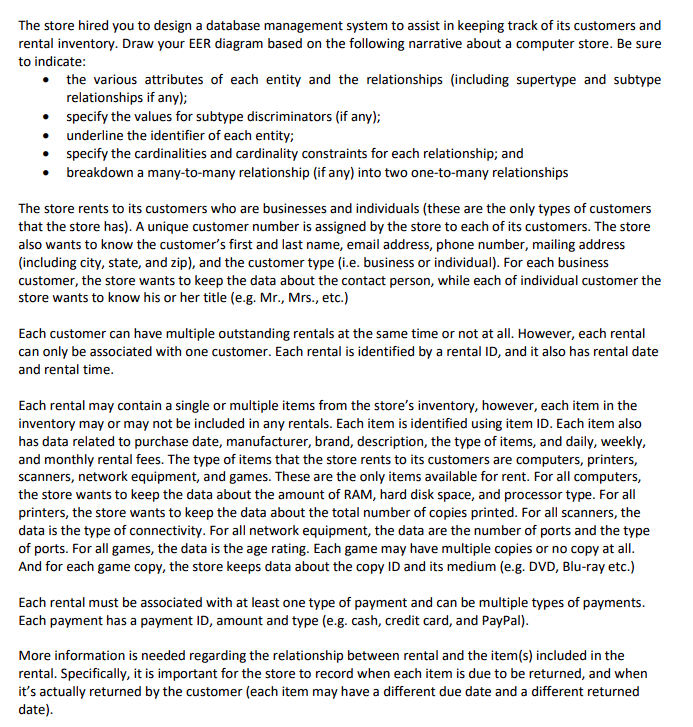
The store hired you to design a database management system to assist in keeping track of its customers and rental inventory. Draw your EER diagram based on the following narrative about a computer store. Be sure to indicate: - the various attributes of each entity and the relationships (including supertype and subtype relationships if any); - specify the values for subtype discriminators (if any); - underline the identifier of each entity; - specify the cardinalities and cardinality constraints for each relationship; and - breakdown a many-to-many relationship (if any) into two one-to-many relationships The store rents to its customers who are businesses and individuals (these are the only types of customers that the store has). A unique customer number is assigned by the store to each of its customers. The store also wants to know the customer's first and last name, email address, phone number, mailing address (including city, state, and zip), and the customer type (i.e. business or individual). For each business customer, the store wants to keep the data about the contact person, while each of individual customer the store wants to know his or her title (e.g. Mr., Mrs., etc.) Each customer can have multiple outstanding rentals at the same time or not at all. However, each rental can only be associated with one customer. Each rental is identified by a rental ID, and it also has rental date and rental time. Each rental may contain a single or multiple items from the store's inventory, however, each item in the inventory may or may not be included in any rentals. Each item is identified using item ID. Each item also has data related to purchase date, manufacturer, brand, description, the type of items, and daily, weekly, and monthly rental fees. The type of items that the store rents to its customers are computers, printers, scanners, network equipment, and games. These are the only items available for rent. For all computers, the store wants to keep the data about the amount of RAM, hard disk space, and processor type. For all printers, the store wants to keep the data about the total number of copies printed. For all scanners, the data is the type of connectivity. For all network equipment, the data are the number of ports and the type of ports. For all games, the data is the age rating. Each game may have multiple copies or no copy at all. And for each game copy, the store keeps data about the copy ID and its medium (e.g. DVD, Blu-ray etc.) Each rental must be associated with at least one type of payment and can be multiple types of payments. Each payment has a payment ID, amount and type (e.g. cash, credit card, and PayPal). More information is needed regarding the relationship between rental and the item(s) included in the rental. Specifically, it is important for the store to record when each item is due to be returned, and when it's actually returned by the customer (each item may have a different due date and a different returned date)







